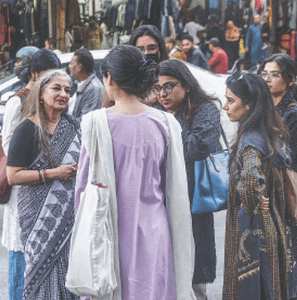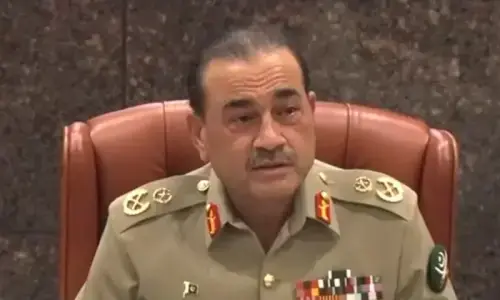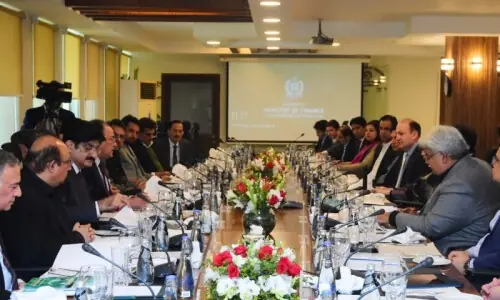 KARACHI, June 1: While the main target of the terrorists, the Consulate General of the United States, has been further fortified and fully repaired, another important building, the Frere Hall, located across the road which was also affected partially, has not yet attracted the attention of its caretakers — the city district government — for repairs and conservation.
KARACHI, June 1: While the main target of the terrorists, the Consulate General of the United States, has been further fortified and fully repaired, another important building, the Frere Hall, located across the road which was also affected partially, has not yet attracted the attention of its caretakers — the city district government — for repairs and conservation.
The blast that rocked the area nearly a year back was so severe that all the windowpanes were shattered, solid teak-wood doors were uprooted, the false decorative ceilings in different rooms caved in, bookshelves in the library were broken, nets on the windows of the arcade vanished into thin air, but luckily no apparent damage was done to the double-storey solid sandstone building of the Frere Hall in the middle of spacious lawns sandwiched between the Fatima Jinnah Road and the Abdullah Haroon Road.
A visit to the over 150-year-old building showed that the library functioning in the ground floor of the Frere Hall is in poor condition. The library has over 40,000 books, some of which are rare old books published in the 17th century, besides many valuable manuscripts.
Some of the solid teak-wood bookshelves that were broken due to the blast are yet to be repaired. As many of the doors and windowpanes had also broken down the valuable books were exposed to birds which found the buildings spacious halls a very hospitable environment to reside with their large families.
A large number of birds had settled in the building and still could be seen flying around while the readers were going through the newspapers and books in the reading room. Many of the books — covered with a thick layer of dust and bird droppings — were in a bad shape.
The entire elevated platform, which could be approached through a couple of solid teak-wood stair-cases, housing many book shelves was all covered with a thick layer of dust that probably had settled in while the doors and windows, some of which have been repaired, were broken.
The doors, windows and nets of the first floor which houses Gallerie Sadequain have not yet been fully repaired, exposing the pieces of art of the leading painter Sadequain and other artists to dust and bird droppings.
Some display panels, some windowpanes, a few doors, a false ceiling had been repaired on a self-help basis, but not by the government. The sliding metallic roof was had also damaged from a few places and need immediate repairs.
Responding to Dawn queries, Deputy Director Culture Nazeer Ahmad Malik said that he had written many letters to the head office for the repairs, but so far nothing has happened. He said that a few organizations that were organizing their events in the hall had helped and some repairs had been done.
A plaque on the entrance to the first floor of the building says: “Erected by the people of Sind as a memorial of their esteem and gratitude to his Excellency Sir Heart Bartle Edward Frere, Governor of Bombay, who had served as Sindh Commissioner for nine years — January 1851 to August 1859”. The building commenced in August 1863 and it was opened to the public on Oct 10, 1865. Two years later, Bertle Frere, who had become Governor of Bombay, held a Darbar at the hall.
With the completion of Frere Hall in 1865 Karachi acquired its first neo-Gothic building, or what may be more appropriately called Indo-Gothic building because of the local influences, significantly, it was a building not for ecclesiastical but for civic use.
Bertle Frere was the first East India Company cadet in 1834 who arrived in India by overland route, and who during his days as the Commissioner of Sindh distinguished himself by his ability and promptitude to the Government of India during the 1857 mutiny. Soon he was promoted and made Governor of Bombay. Notwithstanding his efficiency, being a nephew of Hockham Frere, an ally and friend of Viceroy George Cunnings, had been an advantage, and probably a reason for promotion.
After his departure from Sindh the people decided to have a landmark built in his name. Twelve designs were submitted but the design of Lt Col H. St. Clair Wilkins was selected. The total cost of the Frere Hall was around Rs180,000 — Rs 22,500 were collected from the public subscription; government contributed Rs 10,000; and Rs 147,500 was allocated by the Karachi Municipality, which was formed during his tenure in Sindh.
The construction of Frere Hall began in August 1863, and, although not yet complete, it was opened on Oct 10, 1865, by the Commissioner S. Mansfield. On completion the ground floor of the building was utilized for the first Museum of Karachi and the municipal library.
A landmark of the city, the building is primary built of buff colour stone quarried from nearby Gizri, the polychromatic effect in the columns of the pointed arches was created by the interspersing of white Oolite limestone, brought by train from Bholari 97 miles away, as well as by dark grey and red stone procured from Jungshahi some 53 miles away.
The pitched roof was designed with a steep slope, more suitable for shedding snows or rains in icy Europe than for the hot and humid Karachi climate. Part of the roof was composed of clay tile covering, while the rest was corrugated iron imported from England.
The 144-foot high spirelet and the octagonal tower were covered with Muntz’s metal. The deep verandahs of the Frere Hall, which employ pointed arches, provide shade from strong afternoon sun, reflecting an understanding of the climatic requirements.
The building is relatively in a better condition than majority of the historical monuments, that have been protected under the Sindh Cultural Heritage Act. However, unruly visitors showing disrespect to the architectural gem have also written their names on the plaques and the stone building which look ugly.
If the broken and damaged doors, windowpanes, nets etc are not repaired soon the valuable books in the library and pieces of art on display at the Gallerie Sadequain would be further affected. However, to clear the thick layer of dust and bird droppings from the books and book shelves, the library staff has to be motivated to do their job efficiently, for which they have been posted and are paid from the public funds!
































